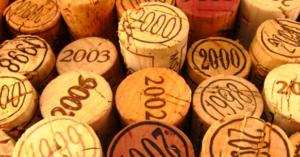Wine snobs are (in)famous for their adulation of certain vintages. “Ahh, the ’82 Bordeaux” one might croon, while another swoons over 1997 California Cabs. We plead guilty to some of that, because we often try to buy certain favorite wines in years that are reputed to be top-tier or a millésime, as the French say.
However, we have found that many people we know don’t really care about the year a wine was made. There is a certain logic to that way of thinking, especially for those who primarily drink wines from California. The relative equanimity of the climate there, especially compared with wines from areas with more variable weather, such as Burgundy, means that there is less variability in the quality of Californian wines, year over year.
Photo courtesy of Vine Pair.
That is not to say that there aren’t better and worse years in Napa Valley or Sonoma County, for example. 2011 was a stinker, while the following three years were among the best. For the most part, the distinction is only evident in the pricier premium wines. If all you want is something to go with a burger and fries in the backyard, buy a good label and don’t worry about which year it was made.
But if you are on a wine tasting trip, it may be interesting to try to evaluate vintages. Here are a few tips if you want to try.
- Develop a sensory memory. Yeah, sure, nothing to it. Some of the greatest experts have trouble with this, so don’t feel too bad if you can’t remember the aroma and taste of the wine you sipped an hour ago, much less days or weeks. Still, if you know in advance that you will be visiting a winery that you particularly like, open a bottle of that wine and really concentrate on the smell, mouth feel and taste. Maybe even write down your sensations and then really try to remember when you are tasting other vintages. Good luck.
- Taste a vertical. A vertical is a selection of the same wine from different years, often successive years. This is really the best way to evaluate the differences between years, but is somewhat difficult (or at least expensive) to accomplish. Many of the better wineries have older bottles, called library wines, available for tasting for a fee. Lining up a few glasses with the same wine from different years exposes much about the terroir and the winemaker’s art, and helps tasters to develop their knowledge of wine.
- Make your own vertical. You don’t have travel to a winery to have access to a vertical. If you belong to a wine club, you will probably receive the same wine from each year’s harvest. If you put down some of those wines, they’ll be available to open two or three from different years and compare them. It’s a good idea to do this with some friends, since you don’t want to finish two or three bottles yourself and you don’t want to lose some of your most treasured wines.
All of this is for academic or at least snobbish reasons. The point of wine tasting is not to parade your expertise but rather to enjoy what’s in the glass in front of you or if you don’t, to know why. You can look up the consensus opinions on the quality of a certain vintage in a certain locale and adjust your buying – and sipping – accordingly.
